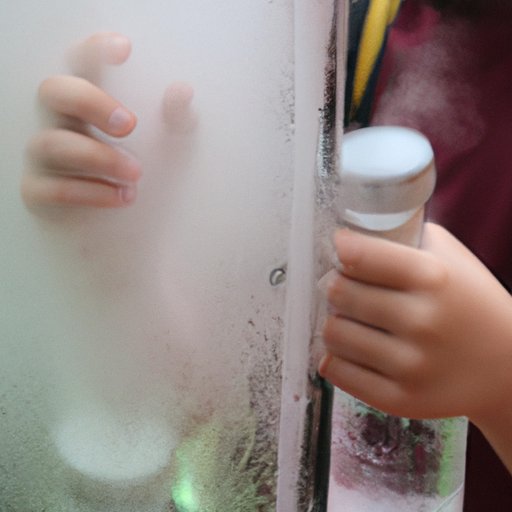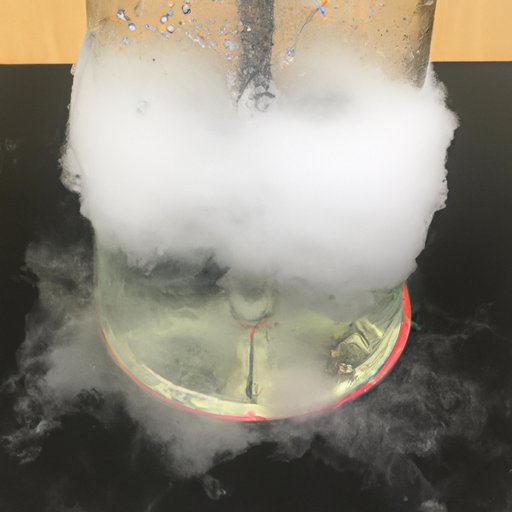Introduction
Condensation is a process that occurs when water vapor in the air turns into liquid. It is a natural phenomenon that plays an important role in the water cycle and has a direct impact on our climate and environment. In this article, we will explore the science behind condensation, including an overview of the problem, an exploration of the physics and chemistry of condensation, and different types of condensation.

Exploring the Science Behind Condensation
In order to understand condensation, it is important to first understand what it is. Condensation is the process by which water vapor in the air turns into liquid. This process occurs when the temperature of the air reaches a point where it can no longer hold the vapor, and the vapor cools and condenses into droplets. This is why you often see dew on grass or fog on windows.
A closer look at how condensation works reveals that the rate of condensation depends on the amount of water vapor in the air, the temperature of the air, and the presence of other particles such as dust or salt. As the air cools, the amount of water vapor it can hold decreases, so more of the vapor condenses into droplets. This explains why dew appears on cold nights or why fog forms in the early morning when temperatures are low.
The role of condensation in nature is significant. It is an important part of the water cycle and helps to regulate the temperature of the planet. When warm air rises and cools, it creates clouds and rain, which help to cool the planet down. In addition, condensation is responsible for the formation of rivers, lakes, and oceans, as the droplets of water eventually fall back down to the Earth’s surface.
Understanding the Physics and Chemistry of Condensation
Now let’s take a look at the physics and chemistry behind condensation. In order for water vapor to become liquid, it must go through a process known as nucleation. Nucleation is a process in which tiny particles called nuclei form in the air and act as a seed around which the vapor molecules can cluster and form droplets. These droplets then grow larger until they become visible as liquid.
The relationship between temperature and humidity is also important in understanding condensation. As the temperature drops, the amount of water vapor that the air can hold decreases. This means that if the air is saturated with water vapor, any additional vapor will turn into droplets of liquid. Conversely, if the humidity is low and the air is not saturated with water vapor, the temperature must drop even further before condensation occurs.
The process of evaporation and transpiration also play a role in condensation. Evaporation is the process by which liquid water turns into water vapor, while transpiration is the process by which plants and animals release water vapor into the atmosphere. Both processes increase the amount of water vapor in the air, which can lead to increased condensation in certain conditions.

The Science of Water Vapor Condensation
Now that we have explored the basics of condensation, let’s take a look at what causes it. Condensation occurs when the air is saturated with water vapor and the temperature drops below a certain point. This point is known as the dew point and is determined by the amount of water vapor in the air and the temperature of the air.
There are several different types of condensation that can occur. The most common type is dew, which is the formation of tiny droplets of liquid on surfaces such as glass or leaves. Other forms of condensation include frost, which occurs when temperatures drop below freezing, and fog, which is a cloud of tiny droplets that form when the air is saturated with water vapor.
Examples of condensation can be seen in everyday life. On a hot summer day, you may notice beads of sweat forming on your skin. This is an example of condensation. Similarly, when you take a hot shower, you may notice steam rising from the shower. This is also an example of condensation, as the hot water vapor is cooling and turning into liquid.
Conclusion
In conclusion, condensation is an important process in nature that plays a significant role in the water cycle. It occurs when the air is saturated with water vapor and the temperature drops below a certain point. We can observe condensation in everyday life, such as in the form of sweat or steam. The science behind condensation involves understanding the physics and chemistry of nucleation, temperature, and humidity. By understanding condensation, we can better understand our environment and take steps to mitigate its effects.
(Note: Is this article not meeting your expectations? Do you have knowledge or insights to share? Unlock new opportunities and expand your reach by joining our authors team. Click Registration to join us and share your expertise with our readers.)
